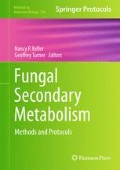Abstract
Targeted gene deletions and promoter replacements are proving to be a valuable tool for awakening and analyzing silent secondary metabolism gene clusters in Aspergillus nidulans and, as molecular genetic methods for manipulating the genomes of other fungi are developed, they will likely be as valuable in those organisms. Here we describe procedures for constructing DNA fragments by PCR that can be used to replace genes or promoters quickly and on a large scale. We also describe transformation procedures for A. nidulans that allow these fragments to be introduced into target strains efficiently such that many genes or promoters can be replaced in a single experiment.
Access this chapter
Tax calculation will be finalised at checkout
Purchases are for personal use only
References
Keller NP, Turner G, Bennett JW (2005) Fungal secondary metabolism—from biochemistry to genomics. Nat Rev Microbiol 3:937–947
Galagan JE, Calvo SE, Cuomo C et al (2005) Sequencing of Aspergillus nidulans and comparative analysis with A. fumigatus and A. oryzae. Nature 438:1105–1115
Machida M, Asai K, Sano M et al (2005) Genome sequencing and analysis of Aspergillus oryzae. Nature 438:1157–1161
Nierman WC, Pain A, Anderson MJ et al (2005) Genomic sequence of the pathogenic and allergenic filamentous fungus Aspergillus fumigatus. Nature 438:1151–1156
Nayak T, Szewczyk E, Oakley CE et al (2006) A versatile and efficient gene-targeting system for Aspergillus nidulans. Genetics 172:1557–1566
Chiang YM, Chang SL, Oakley BR et al (2010) Recent advances in awakening silent biosynthetic gene clusters and linking orphan clusters to natural products in microorganisms. Curr Opin Chem Biol 15:1–7
Bok JW, Chiang YM, Szewczyk E et al (2009) Chromatin-level regulation of biosynthetic gene clusters. Nat Chem Biol 5:462–464
Yu JH, Butchko RA, Fernandes M et al (1996) Conservation of structure and function of the aflatoxin regulatory gene aflR from Aspergillus nidulans and A. flavus. Curr Genet 29:549–555
Bergmann S, Schumann J, Scherlach K et al (2007) Genomics-driven discovery of PKS-NRPS hybrid metabolites from Aspergillus nidulans. Nat Chem Biol 3:213–217
Chiang YM, Szewczyk E, Davidson AD et al (2009) A gene cluster containing two fungal polyketide synthases encodes the biosynthetic pathway for a polyketide, asperfuranone, in Aspergillus nidulans. J Am Chem Soc 131:2965–2970
Szewczyk E, Chiang YM, Oakley CE et al (2008) Identification and characterization of the asperthecin gene cluster of Aspergillus nidulans. Appl Environ Microbiol 74:7607–7612
Chiang YM, Szewczyk E, Nayak T et al (2008) Molecular genetic mining of the Aspergillus secondary metabolome: discovery of the emericellamide biosynthetic pathway. Chem Biol 15:527–532
Chiang YM, Szewczyk E, Davidson AD et al (2010) Characterization of the Aspergillus nidulans monodictyphenone gene cluster. Appl Environ Microbiol 76:2067–2074
Sanchez JF, Chiang YM, Szewczyk E et al (2010) Molecular genetic analysis of the orsellinic acid/F9775 gene cluster of Aspergillus nidulans. Mol Biosyst 6:587–593
Sanchez JF, Entwistle R, Hung JH et al (2011) Genome-based deletion analysis reveals the prenyl xanthone biosynthesis pathway in Aspergillus nidulans. J Am Chem Soc 133:4010–4017
Kuwayama H, Obara S, Morio T et al (2002) PCR-mediated generation of a gene disruption construct without the use of DNA ligase and plasmid vectors. Nucleic Acids Res 30:E2
Yang L, Ukil L, Osmani A et al (2004) Rapid production of gene replacement constructs and generation of a green fluorescent protein-tagged centromeric marker in Aspergillus nidulans. Eukaryot Cell 3:1359–1362
Szewczyk E, Nayak T, Oakley CE et al (2006) Fusion PCR and gene targeting in Aspergillus nidulans. Nat Protoc 1:3111–3120
Weidner G, d’Enfert C, Koch A (1998) Development of a homologous transformation system for the human pathogenic fungus Aspergillus fumigatus based on the pyrG gene encoding orotidine 5′-monophosphate decarboxylase. Curr Genet 33:378–385
Doy CH, Pateman JA, Olsen JE et al (1985) Genomic clones of Aspergillus nidulans containing alcA, the structural gene for alcohol dehydrogenase and alcR, a regulatory gene for ethanol metabolism. DNA 4:105–114
Waring RB, May GS, Morris NR (1989) Characterization of an inducible expression system in Aspergillus nidulans using alcA and tubulin-coding genes. Gene 79:119–130
Oakley BR, Rinehart JE, Mitchell BL et al (1987) Cloning, mapping and molecular analysis of the pyrG (orotidine-5′-phosphate decarboxylase) gene of Aspergillus nidulans. Gene 61:385–399
Vishniac W, Santer M (1957) The thiobacilli. Bacteriol Rev 21:195–213
Pontecorvo G, Roper JA, Hemmons DW et al (1953) The genetics of Aspergillus nidulans. Adv Genet 5:141–238
Lee SB, Taylor JW (1990) Isolation of DNA from fungal mycelia and single spores. In: Innis MA, Gelfand DH, Sninsky JJ, White TJ (eds) PCR protocols: a guide to methods and applications. Academic Press, Inc., San Diego; New York, pp 282–287
Acknowledgement
This work was supported by grants R01GM31837 and PO1GM084077 from the NIH and by the Irving S. Johnson fund of the Kansas University Endowment.
Author information
Authors and Affiliations
Corresponding author
Editor information
Editors and Affiliations
Rights and permissions
Copyright information
© 2012 Springer Science+Business Media, LLC
About this protocol
Cite this protocol
Oakley, C.E., Edgerton-Morgan, H., Oakley, B.R. (2012). Tools for Manipulation of Secondary Metabolism Pathways: Rapid Promoter Replacements and Gene Deletions in Aspergillus nidulans . In: Keller, N., Turner, G. (eds) Fungal Secondary Metabolism. Methods in Molecular Biology, vol 944. Humana Press, Totowa, NJ. https://doi.org/10.1007/978-1-62703-122-6_10
Download citation
DOI: https://doi.org/10.1007/978-1-62703-122-6_10
Published:
Publisher Name: Humana Press, Totowa, NJ
Print ISBN: 978-1-62703-121-9
Online ISBN: 978-1-62703-122-6
eBook Packages: Springer Protocols

